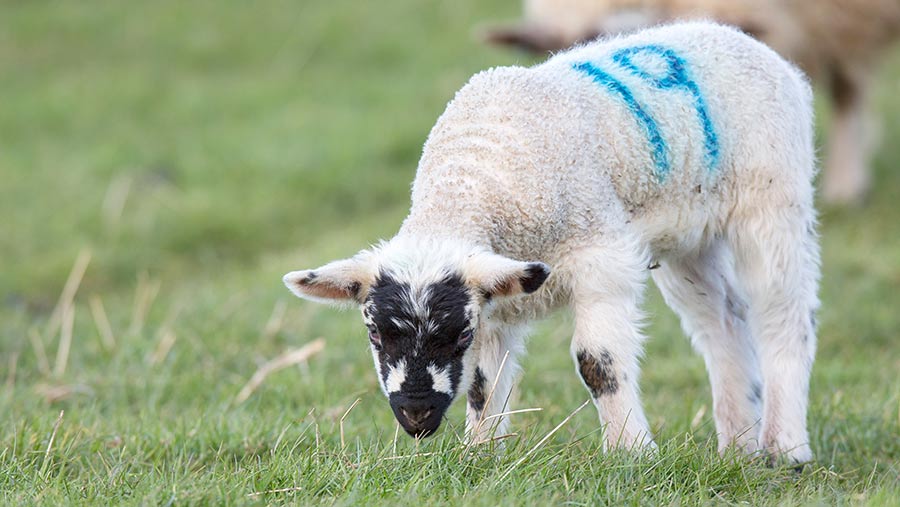6 expert tips to reduce lamb days to slaughter
 © Tim Scrivener
© Tim Scrivener Sheep farmers looking to improve profitability should put more emphasis on getting lambs finished quicker by exploiting good-quality grass.
Selling lambs early contributes 45% to overall profitability. In comparison, achieving good carcass conformation only contributes about 3% to total profitability.
Yet, when questioned on which of the two is more important, farmers tend to resoundingly answer conformation, explained leading sheep specialist John Vipond.
Dr Vipond said the UK’s sheep grading system and selling through live auction tended to “encourage” this way of thinking.
However, during a recent Farming Connect meeting at Welshpool Livestock Market on 29 April, he said the first 100 days of a lamb’s life were when a producer would make or lose money.
“It’s the number of lambs sold at R3L/19kg that really makes the difference. More lambs sold, and away earlier, releases feed to flush your ewes.
“Every day the lambs stay on the farm after weaning takes away a ewe’s flushing feed.”
Below, he outlined a range of factors that could help farmers reduce days to slaughter.
1. Improve grassland management
Sheep farmers need to lower their fixed costs to improve profitability.
“Review what you’re spending your money on. If you have high fixed costs, use a lot of cereals and are having to finish half your lambs inside and not get them away off grass, you’re going to be in a difficult position in the future.”
Dr Vipond said sheep systems can’t compete with the pig and poultry industries, which have better feed conversion rates, or dairy systems, where returns are higher.
He said farmers should aim to produce high-quality grass and finish lambs off grass.
To achieve this, he said they may need to consider establishing brassica crops or using clover.
“You’ve got to look after grass, because that’s the engine of your output.”
2. Match grass demand to supply
Time lambing to coincide with the grass growing season so that ewes and lambs have a plentiful supply of good-quality grass, he said.
“Global warming has increased the growing season by three to six weeks, depending on altitude, so what’s worked in the past may not be quite right now. You have to match the grass supply.”
3. Make good-quality forage
Make big bale silage so you don’t need to feed as much concentrate.
“Providing silage is 12ME, you can cut concentrate feeding to 3kg a ewe a year and save £4 a head.”
He said farmers should aim to have one big bale of 11ME+ to feed five ewes in the last month of pregnancy.
4. Select genetics capable of finishing off grass
Farmers need to use sheep with higher genetic potential.
Animals should be selected based on two key estimated breeding values (EBVs) that influence growth rates.
- Scanning weight: This gives an indication of growth typically at 21 weeks
- Eight-week weight: This gives an indication of growth to eight weeks
5. Creep-feed when necessary and target the right groups
There is a place for creep feeding, especially in a dry season like last year, said Dr Vipond.
“There is a case for some creep feeding; you can spend £3-£5 a head on creep feed,” he advised.
Dr Vipond said producers should target creep feed before weaning, when feed conversion ratios were at their best. Before weaning, lambs put on 4kg for every 1kg of concentrate consumed, but after weaning this deteriorates and they have to eat 8kg of feed to put on the same amount of weight.
Dr Vipond said it could also be cost-effective to target creep feeding of a specific group that you want to get away.
“It might even be a small group of singles and use the ewes to clean up after the other mob.”
6. Control worm burdens
Rain increases worm burdens, with eggs being released onto pasture from dung. They then go on to hatch and produce infective larvae, explained Dr Vipond.
Set-stocking at lambing can make it difficult to manage worm burdens, with ewes and lambs often spread out across all available land.
“Removing the worm burden [by treating] doesn’t remove the challenge if you leave the ewes [in high-risk fields]. If you drench lambs and keep the eggs suppressed, you will still get them 3kg lighter at weaning than if they were never stocked in the first place.”
Rotational grazing can help reduce the risk by providing clean pasture (that hasn’t had sheep on it) for sheep to move on to.
Other management options can also help. See the Sustainable Control of Parasites in Sheep (Scops) website for more information.
Dr Vipond recommended carrying out faecal egg counts (FECs) before and after drenching sheep to ensure the product is effective and to monitor for resistance.
“Worms don’t follow the rules. Whenever I do a worm test, I always get surprising results and every farm is different.”
